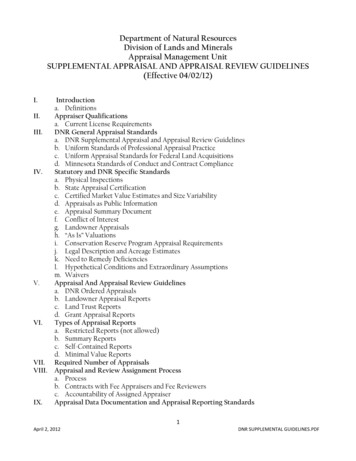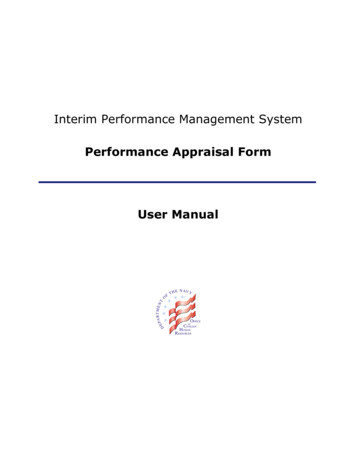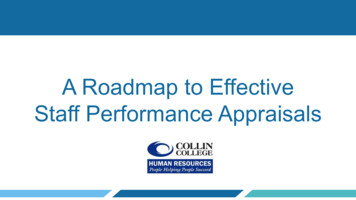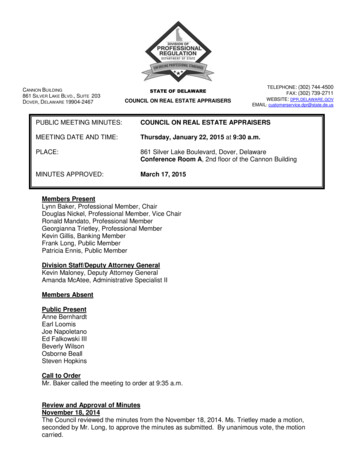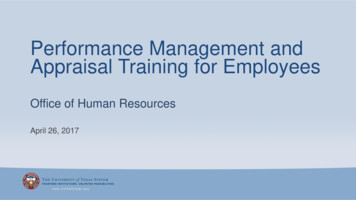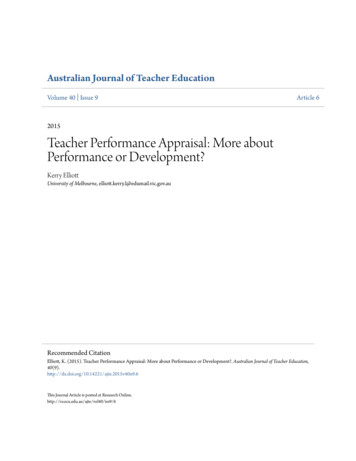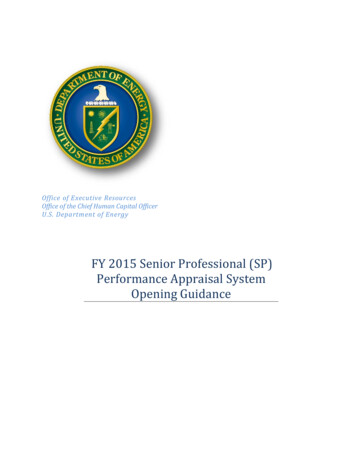
Transcription
Office of Executive ResourcesOffice of the Chief Human Capital OfficerU.S. Department of EnergyFY 2015 Senior Professional (SP)Performance Appraisal SystemOpening Guidance
Table of ContentsContentsI.SP PERFORMANCE APPRAISAL TEMPLATE and TIMELINE . 3II.PERFORMANCE PLAN ‐ CRITICAL ELEMENTS . 3III.SP SUMMARY RATING LEVEL DEFINITIONS. 6IV.DERIVING THE SUMMARY RATING . 7V.TRAINING AND EVALUATION . 8VI.PERFORMANCE PLAN TIPS – SP MEMBER . 8VII. PERFORMANCE PLAN TIPS – RATING OFFICIAL . 8VIII. SMART FRAMEWORK . 9IX.DOE POINTS OF CONTACTS. 92
Fiscal Year 2015Performance Appraisal System OpeningGuidanceThis document provides a summary of the key performance management requirements. Theserequirements should be understood and applied for all Senior Professionals (SP), which include SeniorLevel (SL) and Scientific and Professional (ST), employees in the context of the existing policies.Supervisors must establish performance plans for SP members in consultation with them andcommunicate their written expectations no later than 30 days after the beginning of the rating period.The performance plan must encompass the entire rating period. SP performance plans must includemeasurable outcomes as documented in the DOE’s Strategic Plan. The gaining organization must alsoset performance goals and requirements for any detail or temporary assignment of 120 days or longerand appraise the performance in writing.I.SP PERFORMANCE APPRAISAL TEMPLATE and TIMELINEDATES (2014‐2015)Dec 2014ACTIONSIf needed, please contact HC‐40 for the latest SP PerformanceAppraisal template SP employee prepares his/her 3‐5 key programmaticaccomplishments, DOE Strategic Plan goal linkage, and desiredweights and submits their recommendations to the Rating Official Rating Official reviews submission, discusses with the employee andsigns and dates the Performance Appraisal SP employee signs and dates the Performance AppraisalII.Jan 30, 2015All Performance Plans are completeApr 30, 2015Progress Review completedSep 30, 2015End of Performance Appraisal CyclePERFORMANCE PLAN ‐ CRITICAL ELEMENTSAll SP members will be assessed and rated on two Critical Elements: (1) Key ProgrammaticAccomplishments (3‐5 objectives) and (2) Key Leadership Attributes. Critical Element I focuses on the 3‐5“critical few” program and mission‐related activities linked to the agency’s strategic goals in the SPemployee’s area of responsibility. The total weight for Critical Element I must be 60%. Each key objectivewill be tracked and evaluated in a uniform manner with two primary focuses: (1) how efficiently andeffectively the SP employee executed or obtained the results, and (2) the impact of the results achieved(e.g., program improvements, outcomes, policy impacts).Critical Element I must also identify clear, transparent alignment to relevant agency or organizationalgoals, including page numbers, from DOE’s Strategic Plan, Congressional Budget Justification, or other3
organizational planning document for each performance requirement. Objectives must be measurableand established at the Meets Expectations level.Critical Element II focuses on “how” the SP member carries out his/her responsibilities relative to highlydesirable attributes that are expected of all DOE SP employees. The total weight must be 40% for CriticalElement II. Critical Element II is based on the 5 Executive Core Qualifications (ECQs). The five ECQ’s are:Leading Change, Leading People, Results Driven, Business Acumen and Building Coalitions. Supervisory SPmembers will be assessed against all 5 ECQs and non‐supervisory SP members will be assessed against the4 ECQs as denoted below.1. Leading Change (5% ‐ 10%)ooooooDevelops and implements a vision integrating key national and program goals, priorities,values, and other factors.Balances change and continuity; strives to improve customer service and programperformance and creates a work environment that encourages creativity.Implements organizational vision that aligns key national and program goals andpriorities with Agency and Office Strategic Plans and DOE and Government‐wideinitiatives.Accounts for stakeholders’ need and identifies and analyzes underlying dynamics andinterests creating problems and conflicts including affected internal and external partiesin problem‐solving and conflict resolution.Develops creative insights and innovations and considers them along with conventionalapproaches; generates and evaluates with parties alternative solutions that achievemutually acceptable goals.Builds consensus through focus on underlying interests and mutual gain of parties,demonstrates how collaborative problem solving was considered and used to supportenvironmental and organizational decision‐making.2. Leading People and/or Programs (Supervisory SP only) (5% ‐ 10 %)oooooooDesigns and implements strategies that maximize employee potential and foster highethical standards in meeting the program’s vision, mission and goals.Provides leadership and support to improve the hiring process to recruit and retain adiverse and highly skilled workforce by planning for current and future workforcerequirements, identifying skills required for the job, proactively participating in therecruitment and interviewing processes, and providing assistance to newly hired Federalemployees in accordance with DOE requirements and established timeframes in order tomeet the President’s recruitment and hiring reform objectives.Works to improve the diversity of the organization and ensures that all employee rightsare respected, and takes responsibility for the effective management of employeeperformance. Promotes equal employment opportunity and affirmative action.Ensures that subordinate employees know and understand the organizational strategicgoals and how their positions contribute to meeting organizational goals.Ensures that performance requirements or performance objectives of subordinateemployees are aligned with organizational goals and rigorously appraises subordinateperformance results against clear, measurable performance standards.Provides timely and constructive performance feedback. Promotes teamwork andcollaboration across organizations.Provides training and mentorship to employees on the relationship of program prioritiesto Departmental Strategic Objectives in accordance with the DOE Strategic Plan. Provideshigh‐potential employees with opportunities to work between headquarters and the4
ofield, as well as between line and support functions.Demonstrates two‐way communication with employees and actively solicits employeefeedback and uses the information to inform decisions.3. Business Acumen (5% ‐ 10 %)ooooooAcquires and administers human, financial, material, and information resources in amanner that instills public trust and accomplishes the program’s mission, and uses newtechnology to enhance decision making.Assesses current and future resource needs, including developing and implementingstrategies for workforce planning, based on organizational goals and budget realities. Asapplicable, prepares and implements budget requests which are timely, well‐defined, andinclude appropriate justifications that consider fiscal constraints, program priorities, andhuman capital objectives.Properly executes the operating plan and effectively manages funds. Produces timely andaccurate financial information to support operating, budget and policy decisions.Successfully achieves cost management and other resource management objectives asreflected by reports from the organization’s financial and other management systems.As applicable, effectively promotes and supports meeting the Agency’s smallbusiness/socioeconomic procurement program goals and commitments.Identifies and builds business cases for opportunities to better utilize e‐Governmenttechnology to produce and deliver goods and services, collects and uses information, orcommunicate, consult, collaborate, or partner with stakeholders, in order to improveorganizational/program effectiveness and efficiency.Ensures access and security of technology systems. Establishes and maintains effectiveand efficient management controls in administrative and program areas, and asappropriate, conducts reviews to identify material and other weaknesses. Correctsweaknesses in a timely manner.4. Results Driven (5% ‐ 10 %)oooooooMakes timely and effective decisions and produces results through strategic planning andthe implementation through continuous process improvement and evaluation ofprograms and policies.Sets long‐term and short‐term program objectives that: stress achievement of missionresults, are realistic and measurable, and respond to the Agency Strategic and AnnualPerformance Plans and/or other key Government‐wide or DOE objectives.Effectively structures, organizes and prioritizes work to accomplish the objectives setforth in the Annual Performance Plan and/or appropriate business/work plans, includingmanagement initiatives.Monitors progress toward achieving goals and organizational objectives using effectivemeasures, processes and procedures.Considers customer perspectives and feedback, as appropriate, in adjusting priorities.Takes action to modify operating plans when organizational results and measuresindicate corrective action is needed.Informs higher‐level management of significant program initiatives, developments, andstatus. Holds self and others accountable for measurable, high‐quality, timely and cost‐effective results.Positions the organization for future success by identifying new opportunities; builds theorganization by developing or improving products or services. Takes calculated risks toaccomplish organizational objectives.5
oUnderstands and appropriately applies principles, procedures, requirements, regulations,and policies related to specialized expertise.5. Building Coalitions (5% ‐ 10%)oooooooExplains, advocates, and expresses facts and ideas in a convincing manner to negotiatewith individuals and groups internally and externally.Develops an expansive professional network with other organizations and to identify theinternal and external politics that impact the work of the organization.Articulates program goals and objectives; promotes and supports DOE initiatives andobjectives internally and externally in a clear and convincing manner, particularly whenrepresenting or speaking for the organization or DOE.Effectively identifies and manages internal and external influences and dynamics thatimpact the organization’s work. As appropriate, cultivates alliances, strengthens forsupport internally and externally, and facilitates open exchange of opinion fromstakeholders.Routinely considers and effectively employs collaborative approaches whereverappropriate to build strategic relationships and achieves common goals.Demonstrates two‐way communication with the customers and actively solicits customerfeedback uses the information to inform decisions.Effectively communicates with and listens to customers and stakeholders, gatheringfeedback as appropriate, to inform decisions. Shows evidence of giving feedback dueconsideration, especially in the area of organizational performance. Seeks to build trust inall interactions. Persuades others; builds consensus through give and take; gainscooperation from others to obtain information and accomplish goals.III. SP SUMMARY RATING LEVEL DEFINITIONSThe performance standard definitions for each rating level are specified below: Level 5 (Outstanding): This level is reserved for the truly exemplary employee whodemonstrates the highest degree of achievement in his/her area (s) of work.o This employee demonstrates an extraordinary degree of initiative and self‐reliance inidentifying and resolving problems or requirements of the work situation and indeveloping, recommending or executing innovative solutions successfully to accomplishtasks ahead of target.o The employee is extremely adaptable in adjusting to, and resolving, new, unusual,difficult or complex situations or problems in order to successfully accomplish programobjectives. The employee’s performance and contributions are of such a high level thatthey produce a significant and positive impact on the performance of others and theoperations or reputation of the work unit. Level 4 (Exceeds): This level signifies that the results achieved are clearly beyond what could bereasonably expected. Level 3 (Meets Expectations): This level signifies the employee’s performance results achievedare those that can be reasonably expected of any employee on the job in order to fully andadequately achieve assigned responsibilities. Level 2 (Minimally Satisfactory): This level signifies that there is a significant performance‐related problem(s) although the performance has not reached “Unacceptable” in any CriticalElement. The employee demonstrates limited ability in:6
Producing work of acceptable volume and/or quality within established timeframes; orExhibits limited sense of personal responsibility and accountability in work assignments;orExperiences difficulty in addressing new or unusual work situations under normalpressure; orRequires frequent guidance and assistance from supervisor or others.oooo Level 1 (Unacceptable): This level signifies the performance of the employee consistently fails tomeet the established performance standards in one or more critical elements of the employee’sposition.When performance is rated at this level, a Performance Improvement Plan (PIP) must beimplemented to help the employee improve his/her performance to “MeetExpectations.”oIV. DERIVING THE SUMMARY RATINGThe overall final performance score and rating is determined based on the derivation formula located inTable 1. Within the two Critical Elements, each objective is individually scored based on the Rating Level(Level 1 – Level 5) definitions provided in Section III. The ratings are multiplied by the weight of theobjective. Both Critical Elements are summed to determine the overall performance score (max of 500points) which equates to a corresponding final rating level (Level 1 – Level 5).Table 1: Overall Performance Rating Derivation Formula (Supervisory Example)*EXAMPLERating LevelScoreInitialInitial PointCritical ElementsElementWeightScoreRatingCritical Element 1 (60%): Key Programmatic Accomplishments‐ Objective 15155 X 15 75‐ Objective 24154 X 15 60‐ Objective 33153 X 15 45‐ Objective 43153 X 15 45Critical Element 2 (40%): Key Leadership Attributes1. Leading Change484 x 8 322. Leading People585 x 8 403. Business Acumen383 x 8 244. Building Coalitions484 x 8 325. Results Driven484 x 8 32Total100Final Rating Level Derivation FormulaOutstandingLevel 5475 – 500ExceedsLevel 4387 – 474Level 3300 – 386Level 2200 ‐ 299Level 10 ‐ bleAny CE rated Level 1 Level 13857
V. TRAINING AND EVALUATION All senior professionals must review the annual training SP performance management training.This will constitute training for FY 2015. The training slides are available on the Chief Human CapitalOfficer website for review at the following formance‐management‐training The Department of Energy evaluates the effectiveness of the performance management systemand implements improvements as needed.VI. PERFORMANCE PLAN TIPS – SP MEMBER Key Programmatic Accomplishment (3‐5 objectives) should not exceed one pageo Use bullet or narrative format with a minimum of 10‐point fonto Limit the use of jargon/acronyms and technical terms so goals are better understoodo Eliminate typosEnsure Objectives are:o Written at an executive level with a strategic focus, yet measurable and quantifiableo Focused on outcomes/deliverables rather than meeting milestoneso Not written like a Position Descriptiono Completed with Metrics for Meeting/ExceedingReference a specific DOE Strategic Goalo May use an Organizational Goal that stems from the Strategic GoalProvide a timeframe for completion (not just by Sept 30)Use the SMART FrameworkVII. PERFORMANCE PLAN TIPS – RATING OFFICIAL Ensure objectives are of quality and provide a challenge to the employeeo Communicate changes/edits to be made by employee in the key programmatic objectivesection of the plano Identify performance targets for inclusion that were not identified by the employee Ensure performance targets are realistic and within employee’s controlo Ensure employee is made fully aware of performance expectations Conduct Initial Feedback Session8
VIII. SMART FRAMEWORKPerformance Standards should be Specific, Measurable, Aligned, Realistic, and Timeframe – bound.Specific ‐ Clear, concise statement of what is being measured with observable outcomes.Measurable ‐ Result should be observable or verifiable with a method, procedure or standard toassess and record the result of the requirement.Aligned ‐ A clear, direct connection should exist between Standards and the organizational prioritiesand/or component strategic goals.Realistic ‐ The outcome must be achievable with the resources and personnel available, and it shouldbe within the employee’s control and responsibility.Timeframe ‐ bound ‐ Timeframe needed to complete the Standard should be within the period ofperformance.Tips Use the phrase “as measured by ” to ensure measures have been includedUse multiple measures, when possibleMeasure what is truly critical to the performance of the job – not just what is easiest to measureIX. DOE POINTS OF CONTACTS Contact the Office of Executive Resources for assistance:o Erin Moore; Erin.Moore@hq.doe.gov; (202) 586‐95589
set performance goals and requirements for any detail or temporary assignment of 120 days or longer and appraise the performance in writing. I. SP PERFORMANCE APPRAISAL TEMPLATE and TIMELINE DATES (2014‐2015) ACTIONS Dec 2014 If needed, please contact HC‐40 for the latest SP Performance Appraisal template
